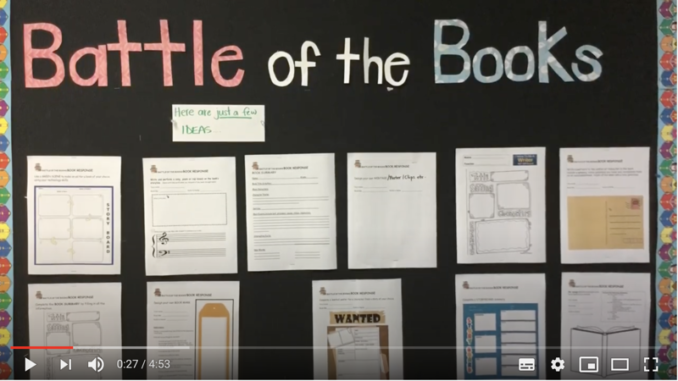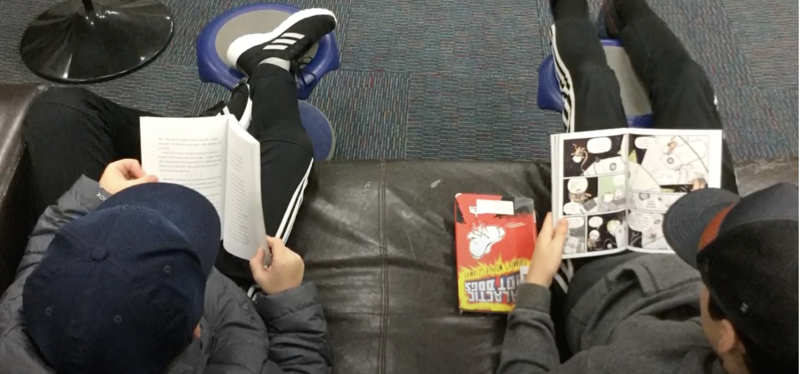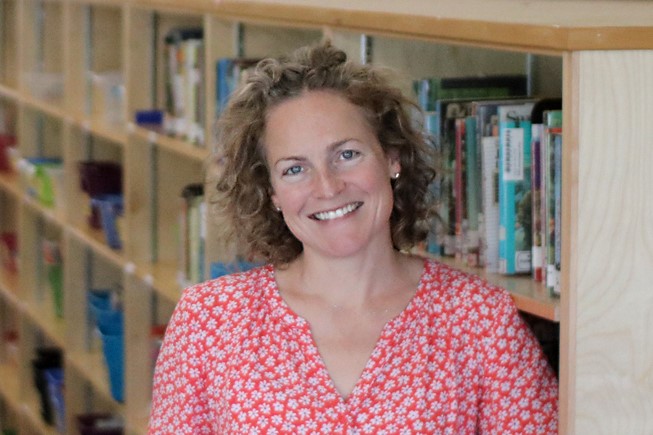
By Lila Armstrong
You may have heard that École Willow Point was one of 10 People’s Choice Winners in the 2019 Follett Challenge! Our library-changing $5,000 win was announced on March 23rd, 2020, but behind the scenes, we had been working hard since September.
Moving Into the Library
When I was hired as the teacher-librarian (TL) at École Willow Point Elementary in Campbell River, BC, I had been working at the school for a year already as a classroom teacher. In addition to my part-time classroom teaching, I accepted a 0.1 FTE in the library. With the mentorship of my primary TL, I got to know the library’s strengths – and its weaknesses. By the time I became primary TL myself, I had a vision in mind of the library I wanted to build.
My goal was simple: turn the library into a Library Learning Commons. If anything had stuck with me from my TL courses, it was the idea that the library should be the hub of the school, and serve as a collaboration centre for the entire school community. While the goal is lofty, and will take a few years to accomplish, the first steps were to build a foundation of student engagement and teacher support, and align the programming with the school learning goals.
We are an immersion school, and I feel the challenge of providing great resources in both languages while managing what space we have in the library. While we hate to remove books from a library, my first to-do item was a weed of both English and French books. Doing so allowed me to bin much of the outdated non-fiction section, and create a sense of successful, independent book choice among students.
Friends in High Places
In October 2019, following the decision of our staff to remove the desktop computers from the room adjacent to the library, I presented my long term goals to the Parent Advisory Committee (PAC). Part of my plan included repurposing the space in the computer room into a flexible learning area and “Maker Space”. I wanted to have a space where students could experiment with design ideas and practice their critical and creative thinking skills with hands-on manipulatives.
Shelves in the library would be moved to make better sight lines, and the school would invest in more comfortable seating. Looking back, I see that I seriously underestimated the price of my dream renovation, but the PAC liked the idea of giving students access to authentic, design-inspired tools, as well as a learning area that was designed to encourage collaboration and a love of reading. The PAC agreed to provide several thousand dollars of funding towards the project.
The Follett Challenge
Part of my responsibility was to find ways to help boost the budget for our project, continue to build a stronger community around the library, and provide a window into activities that were happening in the library. Luckily, I found a way to do all of those things through the Follett Challenge.
The Follett Challenge is held every year, and is open to all educators and all schools in Canada, the U.S. and Australia. The contest rules ask, “Does your school have an incredible program that’s changing the way you teach and your students learn? Enter the Follett Challenge and tell us about it – you might just win a share of $200,000 USD in Follett products and services!” (Follett Challenge Rules).
During the contest window, I was in the midst of getting our Battle of the Books program up and running. The “Battle” has been a district program in Campbell River for 17 years, and every year, TLs form a committee to make book selections. This year, in response to educators and administrators voicing concerns that the Battle (a multiple choice, elimination format competition) focused too heavily on kids regurgitating facts from books, we changed the program to put more importance on the collaborative team aspect, requiring students to show their thinking through pre-Battle activities. Students were provided with examples of how they could show their thinking, and student suggestions were encouraged.
The emphasis for this year’s Follett Challenge was to show how students were engaging in 21st-century learning. According to ISTE, 21st century skills for students include becoming empowered learners, digital citizens, knowledge constructors, innovative designers, computational thinkers, creative communicators and global collaborators. Keeping those ideas in mind, and framing them within an elementary activity guided me through the process of creating an entry.

While the Battle of the Books itself was a long-standing tradition in our district, this year I decided to take on the challenge of moving École Willow Point’s Battle to a digital platform. The timing of a switch to a digital Battle of the Books was perfect. Our district adopted Microsoft 365 this year, and part of my role in the transition was to familiarize students with the apps, login, etiquette and collaboration tools. With 70 grade 3 to 5 students participating in Battle, I was able to teach a large percentage of our student body how to use Office, which in turn opened doors for these students to take on a leadership role in their classrooms. As a result of the students’ growing competence, many classroom teachers felt more comfortable incorporating 365 into their classes. I had a lot of questions from parents, for sure! But this gave me an outlet to share my passion for quality technology integration to whoever would listen.
Because many students had never used any Microsoft programs before, our learning curve was steep. For this reason, we started Battle of the Books earlier than usual – mid-October instead of early January. The collaborative aspect of the new program meant that students picked their teams early and had to stick together – making sure that teammates completed activities, updated their reading logs, and composed group cheers on time. Hosting Battle on the online platform meant that groups could work together in new ways, whether from home, at lunch in the library, or during Battle Club.
Once we had the PowerPoint template downloaded and shared between teammates, we kick started the fun with programs like Clips, an easy video editing app, and Do Ink, a green screen creation app. The teams’ work was uploaded onto PowerPoint so that we could create a portfolio of work for each group. Students created a Wanted Poster, book reviews, and character sketches right in PowerPoint. Because students were accessing Microsoft 365 at home, parents were able to follow along with the work of their child and teammates, and felt positive about the new process, despite technological hiccups along the way. There were many mornings when students ran in to troubleshoot problems that they had at home the night before.
Starting in November, students had two available lunch hours per week to work on projects with my help, or to meet with their team to accomplish tasks. Some lunch hours were set aside for poster making, and the grade 3 participants even had a lunch hour Skype chat with Canadian author and illustrator Carey Sookocheff!
While the video portion of my submission came down to making sure that I had enough footage and time to edit, the essay portion was more difficult. The challenge required four essay answers and a letter of support from an administrator. The questions asked participants to describe the program and its impact on student learning; connect the program to critical and creative thinking, collaboration and communication; explain how the program was implemented; and describe how the program was adapted to include 21st century skills.
The Road to Victory
Once I had submitted my video and essay questions, we began a long wait. In late January, we had a five-day window to collect votes. This is where the magic began to happen, but with no daily vote count, no one in the Follett Challenge knew where they stood compared to other schools.
I posted reminders on my blog daily, on a whiteboard in the entrance of the school, and several parents in the school offered to keep reminders going out on Facebook and by word of mouth. I emailed every teacher in the district asking for support. With the help of my District Librarian, word got out to the news outlets in the city and I was interviewed by a local radio station, 99.7 2Day FM for radio and web news, and The Campbell River Mirror newspaper. Campbell River is a small city of 35,000 people, but one thing that we do well here is lend a hand. I am certain that the press we got for the Challenge helped push us ahead when it came time for voting.
By the time March 23rd arrived, the furor of the voting week had subsided, and schools in B.C. had been closed due to the Covid-19 pandemic. Follett shared their communications online and advertised that the contest winners would be announced as planned, which was a relief as we all needed something to look forward to. Due to a mix-up in time zone math, I missed the live version of the announcement, but saw it one hour later! École Willow Point had placed in the People’s Choice Award category: a win based purely on the number of votes tallied.
I will never know how my essay questions fared, but what I do know is that my community rallied behind a school trying to innovate learning for its students. Campbell River Mirror reporter Marissa Tiel championed our win and let me know that she was interested in continuing to share news about local TLs in the future. For a school of 230 students, this is a very meaningful and powerful message that our community believes in the importance of teacher librarians in our schools, and the positive impact that we can have on our learners.

Lila Armstrong has been teaching in the K-8 classroom for over 10 years and recently moved into an immersion teacher-librarian position at École Willow Point Elementary in Campbell River, BC. She has a B.A. in Political Science, and a Masters of Urban Planning from McGill University, along with a B. Ed from the University of Ottawa. Lila was preparing for a life in politics but realized that teaching was her calling. She and her husband are raising two small readers, and one large Golder Retriever. (Photo credit: Thomas Photography)